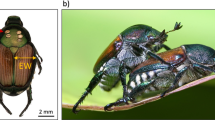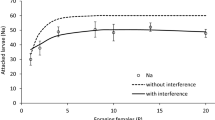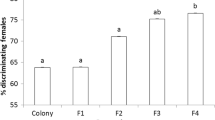Abstract
Ormia ochracea is a parasitoid fly which lays its larvae on its hosts, the field crickets Gryllus integer and Gryllus rubens, in two distinct modes: (1) directly on the host and (2) around the host. In the field, 12.7% of male crickets were parasitized and 3.2% were super-parasitized. Despite the disadvantages of parasitizing infested hosts, there was no evidence that O. ochracea avoided superparasitism. This and other experiments suggest that the host assessment ability of O. ochracea is less than that reported for many hymenopteran parasitoids. by manipulating the number of larvae in each cricket, we determined that four to five larvae per host resulted in the largest number of adult flies. However, as larval number per host increased from one to six, pupal size, and hence adult size, declined. In the field, hosts were found with a mean of 1.7 ± 1.0 (SD) larvae per cricket, suggesting that there may be some selection pressure against larger clutch sizes. Nevertheless clutch sizes larger than the host can support were sometimes found in the field. During the first mode of larviposition, gravid flies deposited no more than three larvae directly onto the host. Larvae deposited directly on the host had a high probability of infesting it. During the second mode of larviposition, gravid flies laid a larger number of larvae around the host (6.1 ± 5.2). Larvae that were laid around the host were less likely to infest a cricket than were larvae that were deposited directly onto it. O. ochracea is unique in that its two different modes of larviposition have different probabilities of larval success. Even though the success rate for larvae laid during the second mode of larviposition was low, the possibility of parasitizing more hosts appears to have selected for flies laying more larvae (e.g. increasing clutch size) than is optimal if all the larvae successfully entered a single host.
Similar content being viewed by others
References
Adamo SA, Robert D, Hoy RR (in press) The effect of a tachinid parasitoid, Ormia ochracea, on the behaviour and reproduction of its field cricket hosts (Gryllus spp.). J Insect Physiol
Adamo SA, Hoy RR (1994) Courtship behaviour of the field cricket Gryllus bimaculatus and its dependence on social and environmental cues. Anim Behav 47: 857–868
Alphen JJM van, Visser ME (1990) Superparasitism as an adaptive strategy for insect parasitoids. Annu Rev Entomol 35: 59–79
Cade W (1975) Acoustically orienting parasitoids: fly phonotaxis to cricket song. Science 190: 1312–1313
Cade WH (1984) Effect of fly parasitoids on nightly calling duration in field crickets Can J Zool 62: 226–228
Cade WH, Cade ES (1992) Male mating success, calling and searching behaviour at high and low densities in the field cricket, Gryllus integer. Anim Behav 43: 49–56
Charnov EL, Skinner SW (1984) Evolution of host selection and clutch size in parasitoid wasps. Fla Entomol 67: 5–21
Godfray HCJ (1987) The evolution of clutch size in invertebrates. Oxford Surv Evol Biol 4: 117–154
Godfray HCJ (1994) Parasitoids: behavioral ecology and evolutionary ecology. Princeton University Press, Princeton
Godfray HCJ, Ives AR (1988) Stochasticity in invertebrate clutchsize models. Theor Popul Biol 33: 79–101
Godfray HCJ, Partridge L, Harvey PH (1991) Clutch size. Annu Rev Ecol Syst 22: 409–429
Hardy ICW, Griffiths NT, Godfray HCJ (1992) Clutch size in a parasitoid wasp: a manipulation experiment. J Anim Ecol 61: 121–129
Hubbard SF, Marris G, Reynolds A, Rowe GW (1987) Adaptive patterns in the avoidance of superparasitism by solitary parasitic wasps. J Anim Ecol 47: 593–604
Lack D (1947) The significance of clutch size. Ibis 89: 309–352
Lederhouse RC, Morse RA, Ambrose JT, Burgett DM, Conner WE, Edwards L, Fell RD, Rutowski R, Turell M (1976) Crepuscular mating aggregations in certain Ormia and Sitophaga. Fla Entomol 69: 656–658
Mangel M (1990) Dynamic information in uncertain and changing worlds. J Theor Biol 146: 317–322
Mangel M (1989) An evolutionary explanation of the motivation to oviposit. J Evol Biol 2: 157–172
Meddis R (1984) Statistics using ranks—a unified approach. Blackwell, Oxford
Robert D, Amoroso J, Hoy RR (1992) The evolutionary convergence of hearing in a parasitoid fly and its cricket host. Science 258: 1135–1137
Roitberg BD, Mangel M (1988) On the evolutionary ecology of marking pheromones. Evol Ecol 2: 289–315
Simmons LW (1986) Inter-male competition and mating success in the field cricket, Gryllus bimaculatus (De Geer). Anim Behav 34: 567–579
Skinner SW (1985) Clutch size as an optimal foraging problem in insects. Behav Ecol Sociobiol 17: 231–238
Sokal RR, Rohlf FJ (1981) Biometry, 2nd edn. Freeman, New York
Souroukis K, Cade WH (1993) Reproductive competition and selection on male traits at varying sex ratios in the field cricket, Gryllus pennsylvanicus. Behaviour 126: 45–62
Spiers DC, Sherratt TN, Hubbard SF (1991) Parasitoid diets: does superparasitism pay? Trends Ecol Evol 6: 22–25
Strand MR (1986) The physiological interactions of parasitoids with their hosts and their influence on reproductive strategies. In: Waage JK, Greathead D (eds) Insect parasitoids. Academic Press, London, pp 97–136
Strand MR, Godfray HCJ (1989) Superparasitism and ovicide in parasitic Hymenoptera: a case study of the ectoparasitoid Bracon hebetor. Behav Ecol Sociobiol 24: 421–432
Vet LEM, Datema A, Welzen K van, Snellen H (1993) Clutch size in a larval-pupal endoparasitoid: variation across and within host species. Oecologia 95: 410–415
Waage JK, Ng SM (1984) The reproductive strategy of a parasitic wasp. I. Optimal progeny allocation in Trichogamma evansecens. J Anim Ecol 53: 401–415
Walker TJ (1986) Monitoring the flights of field crickets (Gryllus spp.) and a tachinid fly (Euphasiopteryx ochracea) in north Florida. Fla Entomol 69: 678–685
Walker TJ, Wineriter SA (1991) Hosts of a phonotactic parasitoid and levels of parasitism (Diptera: Tachinidae: Ormia ochracea) Fla Entomol 74: 554–559
Wilson K, Lessells CM (1994) Evolution of clutch size in insects I. A review of static optimality models. J Evol Biol 7: 339–363
Wineriter SA, Walker TJ (1990) Rearing phonotactic parasitoid flies (Diptera: Tachinidae. Ormiini, Ormia spp.). Entomopbaga 35: 621–632
Wood DM (1987) Tachinidae. In: McAlpine JFM, Peterson BV, Shewell GE, Teskey HJ, Vockeroth JR, Wood DM (eds) Manual of the nearctic Diptera, vol. 2 (Monograph 28) Agriculture Canada, Ottawa, pp 1193–1269
Zuk M, Simmons LW, Cupp L (1993) Calling characteristics of parasitized and unparasitized populations of the field cricket Teleogryllus oceanicus. Behav Ecol Sociobiol 33: 339–343
Author information
Authors and Affiliations
Additional information
Communicated by M.A. Elgar
Rights and permissions
About this article
Cite this article
Adamo, S.A., Robert, D., Perez, J. et al. The response of an insect parasitoid, Ormia ochracea (Tachinidae), to the uncertainty of larval success during infestation. Behav Ecol Sociobiol 36, 111–118 (1995). https://doi.org/10.1007/BF00170716
Received:
Accepted:
Issue Date:
DOI: https://doi.org/10.1007/BF00170716




